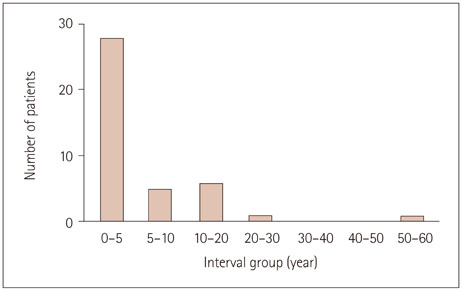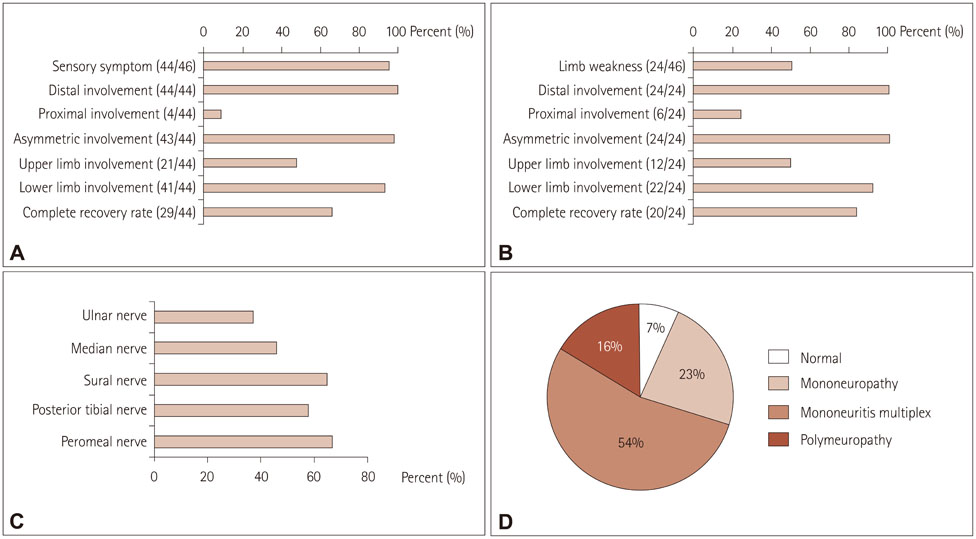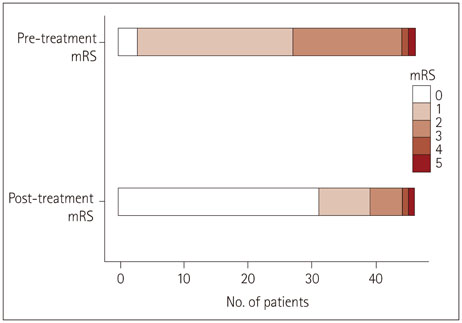J Clin Neurol.
2017 Jan;13(1):77-83. 10.3988/jcn.2017.13.1.77.
Clinical Characteristics and Treatment Response of Peripheral Neuropathy in the Presence of Eosinophilic Granulomatosis with Polyangiitis (Churg-Strauss Syndrome): Experience at a Single Tertiary Center
- Affiliations
-
- 1Department of Neurology, The Catholic University of Korea College of Medicine, Bucheon St. Mary's Hospital, Bucheon, Korea.
- 2Department of Medicine, Samsung Medical Center, Sungkyunkwan University School of Medicine, Seoul, Korea. dcchoi@skku.edu
- 3Department of Neurology, Samsung Medical Center, Sungkyunkwan University School of Medicine, Seoul, Korea. bjkim@skku.edu
- 4Neuroscience Center, Samsung Medical Center, Seoul, Korea.
- 5Department of Pathology, Samsung Medical Center, Sungkyunkwan University School of Medicine, Seoul, Korea.
- KMID: 2364901
- DOI: http://doi.org/10.3988/jcn.2017.13.1.77
Abstract
- BACKGROUND AND PURPOSE
Eosinophilic granulomatosis with polyangiitis (EGPA) is a rare systemic small-vessel vasculitis accompanied by asthma, eosinophilia, and eosinophilic inflammation of various tissues including the peripheral nerves. This study investigated the clinical course and long-term outcomes of peripheral neuropathy in patients with EGPA.
METHODS
Seventy-one patients with physician-diagnosed EGPA were identified at Samsung Medical Center between January 1995 and April 2014. Sixty-one of these patients were followed-up for more than 1 year and received corticosteroid therapy with or without intravenous cyclophosphamide pulse therapy for 6 to 18 months. Medical records of the 61 patients including demographic data, clinical features, laboratory and pathological findings, treatments, and outcomes were reviewed.
RESULTS
Peripheral neuropathy as a manifestation of EGPA was present in 46 (75%) of the 61 patients. The mean follow-up duration of the patients with neuropathy was 6.4 years (range 1.2-18.8 years). The scores on the neurological functional disability scale before and after the combination treatment with corticosteroid and cyclophosphamide were 2.43±0.86 and 0.54±0.95 (mean±SD; p<0.001), respectively. The peripheral neuropathy relapsed in one patient.
CONCLUSIONS
The long-term clinical outcome of peripheral neuropathy in patients with EGPA receiving initial corticosteroid and cyclophosphamide combination therapy was favorable with a very low relapse rate.
Keyword
MeSH Terms
Figure
Cited by 1 articles
-
Eosinophilic granulomatosis with polyangiitis presenting with acutepolyneuropathy mimicking Guillain-Barré syndrome: A case report
Jee Seon Kim, June Hong Ahn, Hyun Jung Jin
Allergy Asthma Respir Dis. 2018;6(1):72-76. doi: 10.4168/aard.2018.6.1.72.
Reference
-
1. Hattori N, Mori K, Misu K, Koike H, Ichimura M, Sobue G. Mortality and morbidity in peripheral neuropathy associated Churg-Strauss syndrome and microscopic polyangiitis. J Rheumatol. 2002; 29:1408–1414.2. Wolf J, Bergner R, Mutallib S, Buggle F, Grau AJ. Neurologic complications of Churg-Strauss syndrome--a prospective monocentric study. Eur J Neurol. 2010; 17:582–588.
Article3. Cattaneo L, Chierici E, Pavone L, Grasselli C, Manganelli P, Buzio C, et al. Peripheral neuropathy in Wegener’s granulomatosis, Churg-Strauss syndrome and microscopic polyangiitis. J Neurol Neurosurg Psychiatry. 2007; 78:1119–1123.
Article4. Oka N, Kawasaki T, Matsui M, Shigematsu K, Unuma T, Sugiyama H. Two subtypes of Churg-Strauss syndrome with neuropathy: the roles of eosinophils and ANCA. Mod Rheumatol. 2011; 21:290–295.
Article5. Yamasaki A, Tomita K, Fujii Y, Hasegawa Y, Watanabe M, Sano H, et al. Repressed ileal artery aneurysms in Churg-Strauss syndrome following combination treatment with glucocorticoid and cyclophosphamide. Rheumatol Int. 2009; 29:335–337.
Article6. Hattori N, Ichimura M, Nagamatsu M, Li M, Yamamoto K, Kumazawa K, et al. Clinicopathological features of Churg-Strauss syndromeassociated neuropathy. Brain. 1999; 122(Pt 3):427–439.
Article7. Samson M, Puéchal X, Devilliers H, Ribi C, Cohen P, Stern M, et al. Long-term outcomes of 118 patients with eosinophilic granulomatosis with polyangiitis (Churg-Strauss syndrome) enrolled in two prospective trials. J Autoimmun. 2013; 43:60–69.
Article8. Ribi C, Cohen P, Pagnoux C, Mahr A, Arène JP, Lauque D, et al. Treatment of Churg-Strauss syndrome without poor-prognosis factors: a multicenter, prospective, randomized, open-label study of seventy-two patients. Arthritis Rheum. 2008; 58:586–594.
Article9. Moiseev S, Novikov P. Five Factor Score in patients with eosinophilic granulomatosis with polyangiitis (Churg-Strauss; EGPA): to use or not to use. Ann Rheum Dis. 2014; 73:e12.
Article10. Comarmond C, Pagnoux C, Khellaf M, Cordier JF, Hamidou M, Viallard JF, et al. Eosinophilic granulomatosis with polyangiitis (Churg-Strauss): clinical characteristics and long-term followup of the 383 patients enrolled in the French Vasculitis Study Group cohort. Arthritis Rheum. 2013; 65:270–281.
Article11. Gayraud M, Guillevin L, Cohen P, Lhote F, Cacoub P, Deblois P, et al. Treatment of good-prognosis polyarteritis nodosa and Churg-Strauss syndrome: comparison of steroids and oral or pulse cyclophosphamide in 25 patients. French Cooperative Study Group for Vasculitides. Br J Rheumatol. 1997; 36:1290–1297.
Article12. Cohen P, Pagnoux C, Mahr A, Arène JP, Mouthon L, Le Guern V, et al. Churg-Strauss syndrome with poor-prognosis factors: a prospective multicenter trial comparing glucocorticoids and six or twelve cyclophosphamide pulses in forty-eight patients. Arthritis Rheum. 2007; 57:686–693.
Article13. Sehgal M, Swanson JW, DeRemee RA, Colby TV. Neurologic manifestations of Churg-Strauss syndrome. Mayo Clin Proc. 1995; 70:337–341.
Article14. de Groot K, Schmidt DK, Arlt AC, Gross WL, Reinhold-Keller E. Standardized neurologic evaluations of 128 patients with Wegener granulomatosis. Arch Neurol. 2001; 58:1215–1221.
Article15. Pagnoux C, Guilpain P, Guillevin L. Churg-Strauss syndrome. Curr Opin Rheumatol. 2007; 19:25–32.
Article16. Sokolowska BM, Szczeklik WK, Wludarczyk AA, Kuczia PP, Jakiela BA, Gasior JA, et al. ANCA-positive and ANCA-negative phenotypes of eosinophilic granulomatosis with polyangiitis (EGPA): outcome and long-term follow-up of 50 patients from a single Polish center. Clin Exp Rheumatol. 2014; 32:3 Suppl 82. S41–S47.17. Kim MY, Sohn KH, Song WJ, Park HW, Cho SH, Min KU, et al. Clinical features and prognostic factors of Churg-Strauss syndrome. Korean J Intern Med. 2014; 29:85–95.
Article
- Full Text Links
- Actions
-
Cited
- CITED
-
- Close
- Share
- Similar articles
-
- Eosinophilic Annular Erythema in a Patient with Eosinophilic Granulomatosis with Polyangiitis (Churg-Strauss Syndrome)
- A Case of Eosinophilic Granulomatosis with Polyangiitis with a Clinical Presentation Similar to Erythema Gyratum Repens
- Eosinophilic Granulomatosis with Polyangiitis: Experiences in Korean Patients
- A pediatric case of eosinophilic granulomatosis with polyangiitis accompanied by heart failure mimicking an asthma attack
- An atypical case of Churg-Strauss syndrome without asthma




